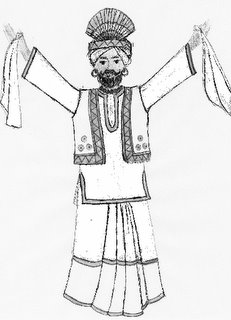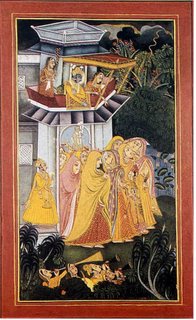
Of Birhas, Babuas and Bhaiyas of UP
Sanket Upadhyay
It’s hard to give Uttar Pradesh expatriates an identity – the state is vast and the culture, tradition, language and style of living changes completely from East to West border. Emotionally speaking, I shouldn’t even dare to typecast people from the state – I myself am from Faizabad district, UP.
But any slow paced individual with shoddy dressing, and a paan-filled mouth trying its best at shayari in Awadhi is enough to describe a large number of UP expatriates anywhere.
The state’s denizens may not be as flamboyant as the Punjabis and colourful as the Rajasthanis, but their sing-along accents and snappy one-liners on everything existing is unique.
The migration is recent. Mostly first generation expats here, Rajasthanis have greeted them in two separate ways over the years. The rich or the influential people, who come on deputation and field postings in the state, are respected (they better be). On the other hand, the rickshaw pullers, daily wageworkers and a fleet of helpless poor, who land in thousands every month, are greeted with scepticism.
“They think anyone who comes from Uttar Pradesh and Bihar is a criminal and would kill people, steal things around and disturb law and order. That is not true. Not all are bad. Some may want to genuinely work here,” 44-year-old rickshaw puller Radheshyam narrates his tale.
Ten years ago, when he started rickshaw pulling in the city, he says, he was often ignored and isolated. The belief of Rajasthnais, he says, got embossed further when a few UP emigrants were found involved in criminal activities. But later, with time and more rickshaw pullers from UP, this gap was bridged. The much sought after query, “Aap UP mein kahan se belaang (belong) karte hain?), still manages to keep relationships healthy among fellow state citizens as well as people from Bihar.
Connoisseurs of art and music, many people are actively involved in theatrical and educational work here also. “We made a film on the plight of the poor, their problems and challenges they face,” says Pink City Cycle Rickshaw Puller Union President Vipin Tiwari. He came to Jaipur in 1982 from Devaria district.
Recently, the Uttar Pradesh-Bihar Sanyukt Samaj organised a cultural evening with a gathering of about 5,000 people from UP. Unforgettably, four alliances for a future marriage within the community were also worked out here. Bhojpuri Birhas, popular in districts of eastern UP were sung here, bringing to life a village-like experience for many.
Folklore is still innate. Chanda mamas, halwa puris and gudiya ranis haven’t faded away in the homes. Also, the straightforward people have always had an edge over the “conservative”, “maintenance of double-standards” and a “subdued” common Rajasthani in arguments.
Many also complain that the new age Rajasthanis are more reserved and want to be left isolated. “They don’t want to mix with other cultures and communities at grass root level,” Tiwari says. Still, there’s a feeling that staying in Rajasthan is much more comfortable. With UP way ahead in crime than this state, life automatically becomes easy here.
Coming to food, expatriate tongues get a homely treat here. The quest for food got a Lucknow food festival to be organised in a city hotel. It was well received by many.
But above all, there’s one Unified Bonding Factor and Unique Selling Proposition (USP) that keeps them together here and everywhere – their want, desire and liking for “Paan”.
All top bureaucrats, Superintendents of Police, Collectors are from UP. All have a liking for paan. Most of the “good” paan sellers are also from UP. “The one close to Ganpati Plaza makes amazing paan – the best indeed,” says Rohit Kumar Singh, Project Director of the Rajasthan Urban Infrastructure Development Project (RUIDP) and importantly, a Varanasi expat in this city since 1992. “I have been selling paan in this city for almost 10 years now. Many people recognise me from my accented Hindi. They feel very nice,” Rajan, a paan waala in Gandhi Nagar says.
As more UP ka bhaiyas migrate into the pink city, it would only increase the expatriate population base here. Whether it means more cultural bonhomie or more friction between traditions, the bhaiyas are here to stay.
--End













